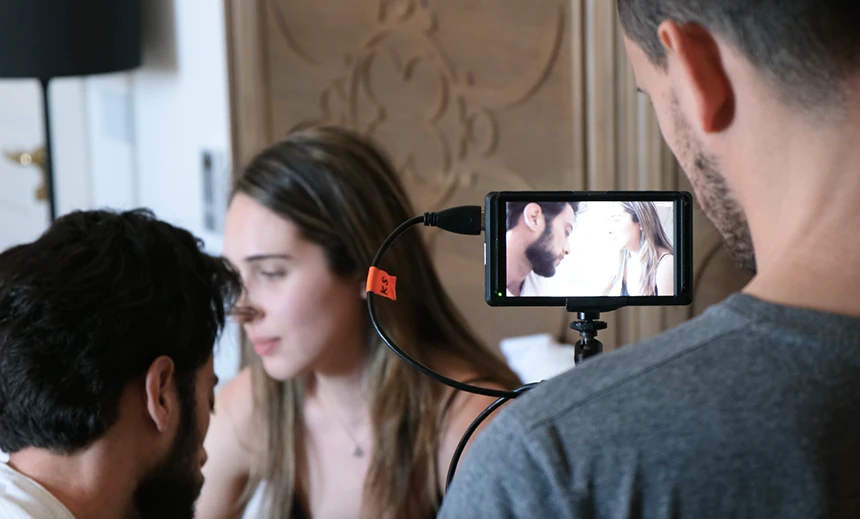Gli effetti “extracorporei” del consumo di materiale pornografico
Immagina un sito web in cui con un semplice clic si possa ferire uno sconosciuto. Non sarebbe sconvolgente? Non ci verrebbe immediatamente da chiuderlo e da chiedere giustizia per le vittime? Sembra un concetto astratto, eppure, in modo meno visibile e forse ancora più inquietante, questo accade ogni giorno. Milioni di persone contribuiscono a un sistema simile ogni volta che accedono a contenuti pornografici. Ma in che modo?

Come fa un’azione apparentemente innocua ad avere delle potenzialità cosi distruttive?
Si potrebbe pensare che, poiché molte attrici e attori scelgono volontariamente di lavorare nell’industria pornografica, tutto avvenga consensualmente. Ma la realtà è ben diversa per una parte significativa delle persone coinvolte. Accanto ai professionisti che scelgono questo percorso, ci sono individui costretti con la forza o il ricatto a recitare in contenuti espliciti. Tra loro, persone minacciate, drogate, ingannate e persino torturate, intrappolate in un sottobosco di violenza e sfruttamento di cui si parla ancora troppo poco.
L’apparente banalità di un clic nasconde un mondo oscuro, in cui ogni visualizzazione significa dire al Mercato “ne voglio ancora!”, e ogni visualizzazione alimenta una domanda che rischia di rendere la violenza e lo sfruttamento sempre più normali. Pensare alla pornografia in questi termini cambia la nostra prospettiva, mostrandoci come il gesto più innocuo possa sostenere un sistema che infligge dolore e devastazione.

Un’industria fuori controllo
All’interno dell’industria pornografica, è estremamente difficile garantire che ogni contenuto sia realmente consensuale, etico o legale. Materiale abusivo e pornografia non consensuale vengono distribuiti su molte piattaforme, anche quelle più mainstream. [2] Basti pensare per esempio che Aylo (ex. MindGeek e Manwin) è stata citata in giudizio da quasi un centinaio di sopravvissuti a forme di sfruttamento sessuale e traffico di minori. [3]
Ma anche in altre piattaforme emerse di recente come OnlyFans sono stati scoperti casi di abusi e purtroppo anche di sfruttamento di minori [2]
Un altro argomento nella difesa della pornografia è che gli attori siano “adulti consenzienti” e “innamorati del proprio lavoro”. Tuttavia, è praticamente impossibile garantire che sia davvero così, il confine tra abuso e consenso è così sfumato che non c’è modo di distinguere l’uno dall’altro.[4] Gli attori e le attrici sono spesso costretti a mentire sulle proprie esperienze e a fingere consenso. Gli spettatori, inconsapevolmente, potrebbero quindi guardare scene di abuso senza la minima consapevolezza di ciò che si cela dietro lo schermo. [1]

Pornografia e Traffico Sessuale: Una Connessione Pericolosa
La pornografia non solo alimenta la domanda di traffico sessuale, ma la sostiene anche in modo strutturale. Una vittima coinvolta in un video pornografico difficilmente potrà rivelare apertamente di essere stata sfruttata; anche se cercasse di manifestare il proprio disagio, sarebbe quasi impossibile per lo spettatore riconoscerlo. Questo perché i contenuti a tema abuso e coercizione sono talmente comuni che tali segnali passano spesso inosservati, e i produttori possono facilmente modificare i video per mascherare la realtà.[ 4]
Il legame tra pornografia e traffico sessuale si manifesta in diversi modi, spesso in modo invisibile per i consumatori:
- Le vittime del traffico sessuale possono essere costrette, ingannate o obbligate a produrre materiale pornografico. [5]
- Attori e attrici coinvolti nell’industria pornografica possono essere sfruttati e forzati a partecipare a scene non consensuali.
- La pornografia può essere usata come mezzo per adescare le vittime del traffico sessuale e “addestrarle” a ciò che ci si aspetta da loro. [5]
- Il consumo di pornografia, specialmente quella violenta, può desensibilizzare gli spettatori, rendendo più accettabile la violenza sessuale. Questo può portare alcuni consumatori a cercare attivamente servizi sessuali, contribuendo così ad aumentare la domanda di traffico e sfruttamento sessuale. [1][4]
Come fare la differenza?
Alla luce di queste inquietanti connessioni, diventa evidente come il consumo di pornografia, per quanto possa sembrare un’azione innocua e personale, contribuisca in realtà a mantenere e alimentare un sistema di abusi e sfruttamento. Prendere coscienza di queste dinamiche nascoste è il primo passo verso un cambiamento profondo e necessario, sia a livello personale che sociale.
Bibliografia
- Wright, P. J., Tokunaga, R. S., Kraus, A., & Klann, E. (2017). Pornography consumption and satisfaction: A meta-analysis. Human Communication Research, 43(3), 315-343. doi:https://doi.org/10.1111/hcre.12108
- Perry S. L. (2020). Pornography and Relationship Quality: Establishing the Dominant Pattern by Examining Pornography Use and 31 Measures of Relationship Quality in 30 National Surveys. Archives of sexual behavior, 49(4), 1199–1213. https://doi.org/10.1007/s10508-019-01616-7
- Perry, S. (2017). Does Viewing Pornography Reduce Marital Quality Over Time? Evidence From Longitudinal Data. Archives Of Sexual Behavior, 46(2), 549-559. Doi: 10.1007/S10508-016-0770-Y
- Maddox, A. M., Rhoades, G. K., & Markman, H. J. (2011). Viewing sexually-explicit materials alone or together: associations with relationship quality. Archives of sexual behavior, 40(2), 441–448. https://doi.org/10.1007/s10508-009-9585-4
- Minarcik, J., Wetterneck, C. T., & Short, M. B. (2016). The Effects Of Sexually Explicit Material Use On Romantic Relationship Dynamics. Journal Of Behavioral Addictions, 5(4) 700-707. Doi: 10.1556/2006.5.2016.078
- Lambert, N. M., Negash, S., Stillman, T. F., Olmstead, S. B., & Fincham, F. D. (2012). A love that doesn’t last: Pornography consumption and weakened commitment to one’s romantic partner. Journal of Social and Clinical Psychology, 31(4), 410-438. doi:10.1521/jscp.2012.31.4.410
- Wright, P. J., Tokunaga, R. S., Kraus, A., & Klann, E. (2017). Pornography consumption and satisfaction: A meta-analysis. Human Communication Research, 43(3), 315-343. doi:https://doi.org/10.1111/hcre.12108
- Rasmussen, K. (2016). A Historical and Empirical Review of Pornography and Romantic Relationships: Implications for Family Researchers. Journal of Family Theory & Review, 8(2), 173-191. doi:https://doi.org/10.1111/jftr.12141
- Skorska, M.N., Hodson, G., & Hoffarth, M.R. (2018). Experimental effects of degrading versus erotic pornography exposure in men on reactions toward women (objectification, sexism, discrimination). The Canadian Journal of Human Sexuality, 27, 261 – 276.
- Seabrook, R. C., Ward, L. M., & Giaccardi, S. (2019). Less than human? Media use, objectification of women, and men’s acceptance of sexual aggression. Psychology of Violence, 9(5), 536-545. doi:10.1037/vio0000198
- Park, B. Y., Wilson, G., Berger, J., Christman, M., Reina, B., Bishop, F., Klam, W. P., & Doan, A. P. (2016). Is Internet Pornography Causing Sexual Dysfunctions? A Review with Clinical Reports. Behavioral sciences (Basel, Switzerland), 6(3), 17. https://doi.org/10.3390/bs6030017
- Bőthe, B., Tóth-Király, I., Griffiths, M. D., Potenza, M. N., Orosz, G., & Demetrovics, Z. (2021). Are sexual functioning problems associated with frequent pornography use and/or problematic pornography use? Results from a large community survey including males and females. Addictive Behaviors, 112, 106603. doi:https://doi.org/10.1016/j.addbeh.2020.106603
- Sun, C., Bridges, A., Johnson, J. A., & Ezzell, M. B. (2016). Pornography and the Male Sexual Script: An Analysis of Consumption and Sexual Relations. Archives of sexual behavior, 45(4), 983–994. https://doi.org/10.1007/s10508-014-0391-2
- Bőthe, B., Tóth-Király, I., Griffiths, M. D., Potenza, M. N., Orosz, G., & Demetrovics, Z. (2021). Are sexual functioning problems associated with frequent pornography use and/or problematic pornography use? Results from a large community survey including males and females. Addictive Behaviors, 112, 106603. doi:https://doi.org/10.1016/j.addbeh.2020.106603
- Szymanski, D. M., & Stewart-Richardson, D. N. (2014). Psychological, Relational, and Sexual Correlates of Pornography Use on Young Adult Heterosexual Men in Romantic Relationships. The Journal of Men’s Studies, 22(1), 64–82. https://doi.org/10.3149/jms.2201.64
- Love, T., Laier, C., Brand, M., Hatch, L., & Hajela, R. (2015). Neuroscience of Internet Pornography Addiction: A Review and Update. Behavioral sciences (Basel, Switzerland), 5(3), 388–433. https://doi.org/10.3390/bs5030388
- Stark R., Klucken T. (2017) Neuroscientific Approaches to (Online) Pornography Addiction. In: Montag C., Reuter M. (eds) Internet Addiction. Studies in Neuroscience, Psychology and Behavioral Economics. Springer, Cham. https://doi.org/10.1007/978-3-319-46276-9_7
- De Sousa, A., & Lodha, P. (2017). Neurobiology of Pornography Addiction – A clinical review. Telangana Journal of Psychiatry, 3(2), 66-70. doi:10.18231/2455-8559.2017.0016
- Voon, V., Mole, T. B., Banca, P., Porter, L., Morris, L., Mitchell, S., Lapa, T. R., Karr, J., Harrison, N. A., Potenza, M. N., & Irvine, M. (2014). Neural correlates of sexual cue reactivity in individuals with and without compulsive sexual behaviours. PloS one, 9(7), e102419. https://doi.org/10.1371/journal.pone.0102419
- Snagowski, J., Wegmann, E., Pekal, J., Laier, C., & Brand, M. (2015). Implicit associations in cybersex addiction: Adaption of an Implicit Association Test with pornographic pictures. Addictive behaviors, 49, 7–12. https://doi.org/10.1016/j.addbeh.2015.05.009
- Gola, M., Wordecha, M., Sescousse, G., Lew-Starowicz, M., Kossowski, B., Wypych, M., Makeig, S., Potenza, M. N., & Marchewka, A. (2017). Can Pornography be Addictive? An fMRI Study of Men Seeking Treatment for Problematic Pornography Use. Neuropsychopharmacology : official publication of the American College of Neuropsychopharmacology, 42(10), 2021–2031. https://doi.org/10.1038/npp.2017.78
- Snagowski, J., & Brand, M. (2015). Symptoms of cybersex addiction can be linked to both approaching and avoiding pornographic stimuli: results from an analog sample of regular cybersex users. Frontiers in psychology, 6, 653. https://doi.org/10.3389/fpsyg.2015.00653
- Laier, C., Pawlikowski, M., Pekal, J., Schulte, F. P., & Brand, M. (2013). Cybersex addiction: Experienced sexual arousal when watching pornography and not real-life sexual contacts makes the difference. Journal of behavioral addictions, 2(2), 100–107. https://doi.org/10.1556/JBA.2.2013.002
- Laier, C., Pekal, J., & Brand, M. (2014). Cybersex addiction in heterosexual female users of internet pornography can be explained by gratification hypothesis. Cyberpsychology, behavior and social networking, 17(8), 505–511. https://doi.org/10.1089/cyber.2013.0396
- Snagowski, J., Laier, C., Duka, T., & Brand, M. (2016). Subjective craving for pornography and associative learning predict tendencies towards cybersex addiction in a sample of regular cybersex users.23(4), 342-360. doi:10.1080/10720162.2016.1151390
- Young K. S. (2013). Treatment outcomes using CBT-IA with Internet-addicted patients. Journal of behavioral addictions, 2(4), 209–215. https://doi.org/10.1556/JBA.2.2013.4.3
- Nathanson, A. (2021). Psychotherapy with young people addicted to internet pornography. Psychoanal.Study Child, 74(1), 160-173. doi:10.1080/00797308.2020.1859286
- Brand, M., Snagowski, J., Laier, C., & Maderwald, S. (2016). Ventral striatum activity when watching preferred pornographic pictures is correlated with symptoms of Internet pornography addiction. NeuroImage, 129, 224–232. https://doi.org/10.1016/j.neuroimage.2016.01.033
- De Sousa, A., & Lodha, P. (2017). Neurobiology of Pornography Addiction – A clinical review. Telangana Journal of Psychiatry, 3(2), 66-70. doi:10.18231/2455-8559.2017.0016
- Laier, C., & Brand, M. (2017). Mood changes after watching pornography on the Internet are linked to tendencies towards Internet-pornography-viewing disorder. Addictive Behaviors Reports, 5, 9-13. doi:10.1016/j.abrep.2016.11.003
- Bridges, A. J., Wosnitzer, R., Scharrer, E., Sun, C., & Liberman, R. (2010). Aggression and Sexual Behavior in Best-Selling Pornography Videos: A Content Analysis Update. Violence Against Women, 16(10), 1065–1085. https://doi.org/10.1177/1077801210382866
- Fritz, N., Malic, V., Paul, B., & Zhou, Y. (2020). A Descriptive Analysis of the Types, Targets, and Relative Frequency of Aggression in Mainstream Pornography. Archives of sexual behavior, 49(8), 3041–3053. https://doi.org/10.1007/s10508-020-01773-0
- Vera-Gray, F., McGlynn, C., Kureshi, I., & Butterby, K. (2021). Sexual violence as a sexual script in mainstream online pornography. The British Journal of Criminology, azab035. doi:10.1093/bjc/azab035
- Bridges, A. J., Wosnitzer, R., Scharrer, E., Sun, C. & Liberman, R. (2010). Aggression and Sexual Behavior in Best Selling Pornography Videos: A Content Analysis Update. Violence Against Women, 16(10), 1065–1085. doi:10.1177/1077801210382866
- Shor, E., & Seida, K. (2019). ‘Harder and Harder’? Is Mainstream Pornography Becoming Increasingly Violent and Do Viewers Prefer Violent Content? Journal of sex research, 56(1), 16–28. https://doi.org/10.1080/00224499.2018.1451476
- Fritz, N., Malic, V., Paul, B., & Zhou, Y. (2020). A Descriptive Analysis of the Types, Targets, and Relative Frequency of Aggression in Mainstream Pornography. Archives of sexual behavior, 49(8), 3041–3053. https://doi.org/10.1007/s10508-020-01773-0


